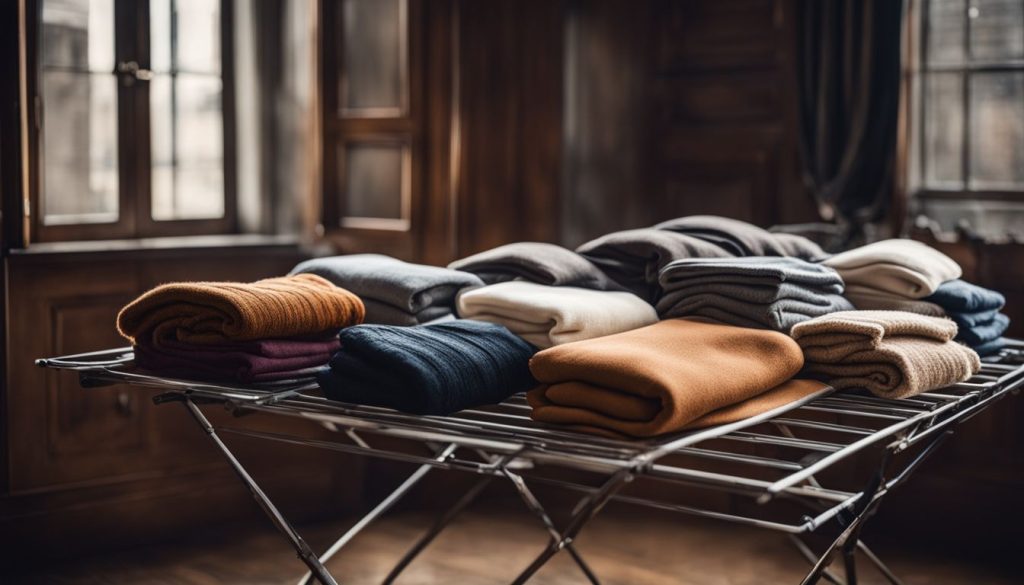
Have you ever pulled a favorite shirt from the dryer only to find it shrunken or misshapen? It’s a common mishap, as certain fabrics and garments can suffer in high heat. This guide will give you the lowdown on what clothes should not go int the dryer, and how to keep them looking great.
Keep reading; your wardrobe will thank you!
Key Takeaways
- Heat can damage delicate fabrics like spandex, silk, lace, and sheer net; it’s best to air dry them flat or hang them to maintain shape and prevent shrinkage.
- Clothes with embellishments such as sequins and beads can break off in the dryer; lay them out to dry instead of using heat that could melt adhesives or damage decorations.
- Use a mesh laundry bag for small or delicate items in the dryer, opt for dryer balls over sheets for more natural softening, and always clean your lint trap after each cycle for safety and efficiency.
- Robust materials like denim and cotton can usually handle the dryer well, but always check care labels first—some items may require low heat settings or specific drying instructions to avoid damage.
- For best fabric care practice: Hang drying is ideal for most clothes especially delicates; avoid overloading the dryer; use lower heat settings when necessary; read clothing labels carefully before proceeding with any kind of drying.
Materials to Avoid Putting in the Dryer
Your dryer may seem like a magic time-saver, but it can be a disaster waiting to happen for certain fabrics. To ensure your clothing remains in top-notch condition, let’s delve into the materials that should steer clear of the heat and tumble of your drying machine.
Spandex (bras, gym clothes, swimwear)
Spandex is a stretchy fabric that’s often found in bras, gym clothes, and swimwear. This material reacts to heat differently than others; exposure to high temperatures can cause it to lose its elasticity.
To maintain your spandex garments’ shape and fit, air drying is the best option. Tossing these items into the dryer not only risks damaging the fibers but also leads to potential shrinkage or warping.
For those who wear spandex-based clothing for sports or swimming, proper care ensures longevity and performance. Instead of using the dryer, lay flat or hang these pieces after washing them in cool water with gentle detergent tailored for delicate fabrics.
Avoid direct sunlight when air drying as it can fade colors and weaken fibers over time. Keeping up with these laundry tips will help your activewear stay snug-fitting and comfortable through many workouts and laps in the pool.
Delicate Fabrics (silk, lace, sheer net)
Just as spandex requires special attention, delicate fabrics like silk, lace, and sheer net demand even more care. These materials are vulnerable to heat damage which makes tossing them into a dryer a risky move.
Silk can lose its sheen and texture under high temperatures while lace might shrink or tear due to its intricate patterns. Sheer net is also prone to snagging and can become misshapen if not handled gently.
To maintain the beauty and longevity of these elegant textiles, air drying is your safest bet.
Opt for laying silk flat on a towel to dry—this prevents the material from stretching out of shape. Lace items do best when they are hung up or laid flat away from direct sunlight that can fade their delicate colors over time.
For sheer net fabrics, smooth them out carefully after washing and place them in an area with good airflow for natural drying without distortion. Always check your laundry labels as they provide valuable garment care instructions tailored for each fabric type’s needs — following these guidelines will help preserve your fine garments’ look and feel for years to come.
Leather, Faux Leather, and Suede
Leather, faux leather, and suede demand special attention in your laundry routine. These materials are highly sensitive to heat and can warp or shrink if exposed to the high temperatures of a dryer.
Place them on a flat surface or use padded hangers for air drying to maintain their shape and texture. Keep these garments away from sunlight too, as it can fade the colors and dry out genuine leather.
Wool items also need careful handling – they’re next on our list of fabrics to avoid putting in the dryer. Their delicate fibers can felt together when heated, causing irreversible damage and shrinking.
To preserve your cozy sweaters and woolen goods, always opt for air drying whenever possible.
Wool
Wool sweaters and other garments need special attention because the heat from a dryer can cause them to shrink, distort, or become felted. Gently squeeze excess water from your woolens after washing, but never wring them out as that can damage their shape.
Lay them flat on a towel to air dry, reshaping them as needed to maintain their original fit and form.
Opting for air drying protects the fabric’s integrity and preserves its natural fibers. Wool items are best kept away from direct sunlight while drying to prevent fading. Always check laundry label instructions before proceeding with any garment care for wool items, ensuring proper fabric handling that extends the life of your clothing.
Clothes With Embellishments (sequins, beads)
Clothes with embellishments like sequins and beads add sparkle to your wardrobe but can become casualties in the dryer. The intense heat and tumbling can cause these delicate decorations to break off or damage the fabric they’re attached to.
Treat these garments with extra care by opting for air drying or using a gentle cycle if you must machine dry.
To keep your embellished clothing looking its best, lay them flat on a towel away from direct sunlight. This method helps preserve the intricate details and prevents any adhesive used for sequins or beads from melting.
By taking these precautions, you’ll ensure that every piece of clothing maintains its original charm and continues turning heads wherever you go.
Safe Materials for the Dryer
While it’s crucial to know what fabrics to keep away from the dryer, some materials can handle the heat and tumble just fine. Let’s look at which common laundry items you can confidently toss into the dryer without a second thought.
Denim
Denim is a hardy fabric that can withstand the heat and tumbling of a dryer without losing its form. Jeans, denim jackets, and other denim garments usually come out of the drying cycle with reduced wrinkles and a comfortable fit.
Make sure to turn your denim items inside out before tossing them in the dryer; this helps maintain their color and prevents fading.
To keep your denim looking fresh, use a medium heat setting. High temperatures can cause shrinkage or damage over time. Regularly emptying the lint trap ensures that your clothes dry efficiently while protecting your durable textiles from excess fuzz or debris buildup.
This simple step in fabric care keeps those favorite jeans ready for wear without excessive maintenance fuss.
Cotton
Cotton garments are generally safe to toss in the dryer, making them a hassle-free option for fast laundry days. This fabric can withstand the heat and tumbling action inside most machines, ensuring that tops, jeans, and bed sheets come out feeling soft and comfortable.
Just keep an eye on the temperature settings; high heat can cause cotton to shrink. It’s best to use a moderate or low setting for optimal fabric care.
To ensure your cotton clothes stay in top shape, clean out the lint trap before starting each drying cycle. Lint buildup from these items can lead to less efficient drying and even pose a fire hazard if not attended to regularly.
Moving forward from natural fibers like cotton, let’s take a closer look at synthetic options such as polyester blends which require their own specific garment care techniques.
Polyester Blends
Polyester blends are often seen as a safe bet for the dryer. These fabrics combine polyester with other materials, creating a durable mix that stands up to high heat and tumbling well.
Unlike pure polyester, which can sometimes handle only low-heat settings, blends tend to resist shrinking and maintain their shape after drying. This makes them ideal for busy households looking for convenience without compromising on garment care.
Not all polyester blends are created equal, though; always check the laundry label instructions before tossing clothes in the dryer. Some might require gentle cycles or lower heat to prevent damage.
Moving forward, bed sheets and pillows typically land on the “safe” list but keep an eye out for specific fabric content and care symbols that could suggest otherwise.
Bed Sheets and Pillows
Bed sheets and pillows can handle the warmth and tumbling of a dryer much better than more delicate items. Cotton sheets, in particular, come out soft and cozy when they’re dried properly.
Just make sure to check the label for any specific fabric care guide instructions before tossing them in with your laundry. Use a medium heat setting to prevent any shrinkage or damage to elastic edges on fitted sheets.
Tossing pillows into the dryer is a great way to fluff them up after washing, but be careful with foam inserts as they might not withstand the heat. For down or feather-filled pillows, throw in a few dryer balls to help maintain their shape without clumping.
Always ensure they are completely dry before using them again; dampness inside can lead to mildew growth – something you definitely want to avoid for clothing preservation and hygiene reasons.
Best Practices for Keeping Your Fabrics Safe While Drying
To maintain the integrity of your clothes and prevent any damage, adopting certain best practices while drying can make a significant difference; stay tuned to uncover how simple adjustments to your routine can safeguard your favorite garments.
Use a Mesh Laundry Bag
Protect your delicate garments in the dryer by using a mesh laundry bag. This simple addition to your laundry routine shields sensitive fabrics from snagging or tangling with other items, ensuring fabric care for materials like lace and silk.
Even small clothing pieces like socks won’t get lost when they’re safely zipped inside these handy bags.
Opt for separate mesh bags for different colors and types of clothing to maintain garment care best practices. Doing so reduces color bleeding and fabric friction, allowing you to dry clothes properly without fear of damaging your favorite outfits.
Not only does this technique extend the life of your clothes, but it also helps preserve their shape and texture during the drying process.
Use Dryer Balls Instead of Dryer Sheets
After safeguarding delicate garments using a mesh laundry bag, consider another fabric care measure by opting for dryer balls over traditional dryer sheets. Dryer balls are an eco-friendly alternative that can improve air circulation within the drum.
This allows your clothes to dry faster and more evenly, which conserves energy and reduces electric bills.
Dryer balls also leave no chemical residues on clothing, making them a safer option for those with sensitive skin or allergies. Unlike dryer sheets that can strip away softness from fabrics over time, wool or rubber dryer balls can actually soften your clothes naturally without the use of synthetic fragrances or potentially irritating substances.
Moreover, these reusable spheres last much longer than disposable sheets, offering you cost-effective garment care and contributing to sustainable laundry practices.
Regularly Clean Your Dryer’s Lint Trap
Switching from dryer sheets to dryer balls can enhance airflow in your machine, and speaking of airflow, keeping your dryer’s lint trap clean is crucial. A clogged lint filter can drastically reduce efficiency, forcing the dryer to work harder than necessary which not only wastes energy but could also increase wear and tear on both your garments and the appliance itself.
Make it a habit to clear out the lint after every load; this tiny step plays a big part in fabric care and extends the life span of your favorite outfits.
Cleaning the trap is more than just about efficiency—it’s also a safety measure. Lint buildup poses a fire risk as dryers generate heat during operation, and excess fluff can ignite under extreme temperatures.
Incorporate cleaning into your laundry routine for peace of mind knowing that you’re preserving not only your textiles but also maintaining proper home safety practices. Keep an eye on this small yet significant detail to ensure that each drying cycle protects rather than harms your clothing investments.
Additional Tips for Protecting Your Fabrics
For those who are dedicated to keeping their wardrobe in pristine condition, our extra tips on fabric protection are crucial. We’ll show you savvy strategies beyond the dryer settings to make sure your garments stay looking fresh and fabulous for years to come.
Hang Dry Delicate Items or Use a Clothing Rack
Hang drying can save your delicate items from the harsh environment of a dryer. Delicate fabrics such as silk, lace, and sheer net need gentle care to preserve their shape and texture.
Draping them over a clothing rack allows air to circulate freely around the fabric, reducing the risk of shrinkage and damage that heat can cause. Especially for garments with embellishments like sequins or beads, laying them flat on a towel or using a hanger helps maintain their design integrity.
It’s not just about fabric protection; this method also conserves energy and extends the life of your precious wardrobe pieces.
Clothing racks are versatile tools in garment care—they’re perfect for air-drying various clothes safely. Use them indoors or out in the fresh air to give your laundry room an extra bit of space for those items that require special attention.
And when it comes to wool sweaters or spandex workout gear, bypassing the dryer altogether by opting for these alternatives keeps fibers from losing elasticity or becoming misshapen.
Implementing proper laundry techniques like hang drying ensures your favorite outfits will look great wear after wear while adhering to laundry best practices.
Avoid Overloading the Dryer
Stuffing the dryer to the brim might seem like a time-saver, but it actually causes more harm than good. Clothes need room to tumble freely for even heat distribution and thorough drying.
Overloading can lead to damp spots on fabrics or, worse, damage to your dryer’s mechanics due to extra stress on its parts. Keep loads manageable; this ensures that all items get an equal amount of airflow and fabric care is at its best.
Resist the temptation to pack in just one more towel or pair of jeans. This not only prevents garments from getting properly dry but also increases wrinkles and wear on textiles. Regularly adhere to laundry best practices by giving clothes their needed space in the machine—it’s essential for clothing preservation and maintaining optimal garment care recommendations.
Use a Lower Heat Setting for Delicate Items
Turn down the heat to protect your dedicates. Fabrics like silk, lace, and sheer net can’t handle high temperatures and may get damaged in the process. By selecting a lower heat setting on your dryer, you ensure that these sensitive materials stay soft and maintain their shape.
It’s a simple step in fabric care that makes all the difference for items that need gentle handling.
Make it a habit to adjust the temperature for each laundry load according to what’s inside. Clothing with embellishments such as sequins or beads also benefit from cooler drying conditions, preventing them from becoming tarnished or detached.
This approach is an essential part of clothing maintenance, extending the life and appearance of your favorite outfits. Keeping an eye on labels helps too—always follow garment care instructions for best results in preserving your wardrobe essentials.
Check Clothing Labels for Care Instructions
Before tossing your clothes into the dryer, always inspect the care labels. These tiny tags are packed with essential information to help you protect your garments and keep them looking their best.
Labels provide specific fabric care instructions that can save you from shrinking, warping, or completely ruining a favorite piece of clothing. They tell you if air drying is better or whether a tumble dry on low heat is safe.
Keep an eye out for symbols and follow garment care recommendations precisely. If it says “lay flat to dry,” find space for your item to rest until it’s ready to wear again. By adhering strictly to these fabric care guidelines, you ensure your wardrobe stays in top condition and lasts longer.
Remembering laundry label instructions can be the difference between preserving the life of your fabrics and having to replace them prematurely due to improper handling.
Conclusion
Taking care of your clothes means knowing which can take the heat and which need a gentler approach. Understanding what clothes should or should not not go in the dryer. Keeping the wrong fabrics out of the dryer to avoid shrinking, warping, or even total ruin.
Embrace these tips for laundry success and remember to treat your garments with respect. Trust in air-drying when necessary, and watch your favorite pieces last longer while looking their best.
After all, smart drying is as important as smart washing!
FAQs
1. Can I put wool sweaters in the dryer?
No, you should not put wool sweaters in the dryer as they may shrink or become misshapen.
2. Is it safe to dry clothes with sequins or beads?
Avoid drying clothes with sequins or beads in the dryer; they could come off or damage the machine.
3. What happens if I dry my sports gear made of high-tech fabric?
Drying sports gear made of high-tech fabrics can ruin their special features and fit.
4. Should I use the dryer for silk dresses and shirts?
Silk dresses and shirts should not go into the dryer because heat can damage delicate silk fibers.
5. Can I tumble dry garments with rubber or plastic attachments?
It’s best not to tumble dry garments with rubber or plastic attachments as these materials could melt or warp.


